Entry Systems 1
Get a PDF Download of this article here.
Entry Systems
Planning to Shave Your Handles?
by Steve Watson, Watson’s StreetWorks Rod & Custom
4 Bud Way, Suite 3, Nashua, NH 03063
Doing it Right…the First Time!
So you want to shave the handles off your car or truck to give it that smooth, uncluttered look. Great! But do
you know everything that you need to know so that you will get the right parts and the job will come out the way
you want it?
This booklet on Entry Systems was designed to give you the information that you need on each part of a
complete entry system so that you can make the right choices and get the right parts… the first time!
Questions You Need to Ask
To start designing your system consider the following – How do you want your system to operate? There are a
variety of “actuators” and ways to trigger them. What type of switches fit your needs? Are you keeping your
original latches? Are they in good working condition?
The answers to these questions will lead you to make selections in 4 separate sub-systems: the Safety
System (locking and back-up entry), the Triggering System (the switches or remote control), the Power
System (what actually releases the latches), and the Latches themselves.
Let’s look at each of these 4 sub-systems so that we can make the right choices.
 Latches… The Last Thing Comes First
Latches… The Last Thing Comes First
The first question to answer is about your latches – original or “bear-claw”? If
your original latches are in good working condition and you want to keep
them, you can. For street rods and most vehicles through at least the ’60’s
that means you will need more power to pull the strong springs in those units.
(A few extra tricks may be needed, too!) Often 15-20 pounds or more of pull is needed just to overcome the
latch spring and small “can” solenoids or gear-motor actuators will NOT cut it. We cannot stress this strongly
enough. Don’t let anyone sell you parts that aren’t strong enough to do the job. Cheaper isn’t better – better is
better. With original latches, you need the power of StreetWorks solenoids. They’ve been tested at 34 pounds
of pull, and have dependable power for both original and bear-claw latches.
If you have bear-claws or need/want to switch to them, then screw-motor actuators will do the job, but don’t
think this route is cheaper! Both approaches cost almost exactly the same. Make your choice based upon
what you need and want, not upon perceived cost. Going to bear-claws and actuators may even be more work!
Actuators and Solenoids
Let’s get our terms straight.
An “actuator” is anything that actuates or moves something else. We want to actuate our latch and cause it to
release and open the door. We can do that with a gear-motor actuator or a solenoid.
Gear-motor actuators use a small DC motor and either gears or a rackand-pinion
drive. Electricity causes the motor to turn and the gears give us
pull or push depending upon the electrical polarity we applied to the motor.
(Most of the actuators being sold are originally door lock units. This is why
they don’t have the design strength to pull most older latches.) Motor size
and gearing determine their strength which is usually about 12 pounds
maximum.
We can also use a solenoid, which is an electromagnetic actuator devise. Electricity running through a wire
coil creates a magnetic field which acts on an iron core plunger and gives us pull. Wire size and length,
number of coils and plunger size determine strength. StreetWorks Hotshots solenoids have been
independently tested at 34 pounds of pull. Over 2-1/2 times that of a typical actuator. But don’t assume that all
“solenoids” are this strong. Small foreign units on the market mislead many people and as one of our
customers said, “they don’t have the strength to flick the ash off of a cigarette!”.
Your choice should be for the type of actuator, screw-motor or solenoid, and size that will give you the
strength and the depend-ability you need to open your latch. Quality screw-motor actuators and solenoids each
have a job that they are meant to do. Know what you need and ask the supplier how strong their unit is. If they
don’t know or can’t give you a number in pounds of pull (not inch-pounds or foot-pounds which are incorrect
measures!) you just may be buying trouble.
Both types can burn out if ask to do more than they are capable of doing (not burn-up, as some sales people
want you to believe – please, never “buy” fear). The three reasons for actuators or solenoids burning out are –
(#1) The triggering system (switch) sticks “on” or a cheap switch allows current to leak by and overheats the
unit. (#2) The unit is “over-used”, that is, if an actuator is being asked to do more than it can and the switch is
triggered repeatedly or held on for an extended time, the unit also will overheat. And (#3) the unit may have
been defective to begin with (hey, it happens).
Another point to consider is – what are you getting for your money? Are
you buying one piece or are you getting an entire kit? Price can be
deceiving if you aren’t comparing like products. Also, does the supplier
carry a full line of entry products? You ask the questions but did they have
believable answers and provide options for you? StreetWorks has more
Entry System products than anyone else and can tailor a system to
meet your specific needs. Even our catalog has a section on Entry
System Design and is setup to visually present each of the sub-systems.
Give us a call and we will review your specifics and get you what you
need – the first time!
Triggering the Magic – Switches
Now that you have made your latch selection which has determined the type of actuator or solenoid to use –
how do you want to trigger the magic to happen?
My recommendation to all of our customers is to try to imagine yourself walking up to the car
after everything has been done. What do you want to do to open the door? Push a button on a remote control
key fob? Reach down to push a button or pad under the running board or fender? Have a key ring magnet to
swipe past a hidden switch? Any of these are possible at StreetWorks and each one provides a completely
different feel and look to accomplish the same thing. So, let’s review each type.
The simplest and least expensive triggering switches are buttons. Back in the ’50’s,
starter buttons would be used. But they aren’t waterproof nor all that good looking.
Todays answer is waterproof buttons. They’re small and attractive and can be used
with relays if you’re switching solenoids that use more amperage, or without for
actuators. (Remember that our solenoids have 2-1/2 time the pull of gear motor
actuators. They get that strength from amperage, so switches for our solenoids need to be able to switch about
20 – 25 amps.)
A couple of new approaches to switches are seen in StreetWorks MagTechT Magnet Entry System and
PressTechT Touch Pad Entry System.
MagTech uses a key ring magnet to activate a hidden reed switch. The magnet is
encased in a black plastic to prevent any scratching of paint. Just swipe the magnet
past a hidden reed switch (a small cylindrical item with wires) and the door opens.
Now this is really magic ! People can watch you trigger the door and still not realize
how you do it. Since you don’t have to point the magnet at the switch like you would
with a key, you can be very casual with your keys dangling from a finger or hidden in
your hand as you trigger the door. Since it uses magnetism, MagTech doesn’t work through steel but it works
through glass, plastic, fiberglass, aluminum, body filler… there are numerous places to hide the reed switch.
Just ask for ideas.
The PressTechT Entry System is a modern version of waterproof buttons with a
twist. The switch is a thin touch pad about 3/16″ thick by 1″ square. To trigger
your doors you simply press on the pressure pad switch, it triggers the solenoids
and you’re in. But even better than buttons, because they’re thin, they can be
hidden under upholstery or in some very inconspicuous places – like behind a
flexible panel, inside a mirror housing or gas fill door… let your imagination run
wild.
O.K. Let’s do a brief review. So far we’ve talked about triggering our doors with waterproof buttons, with a keyring
magnet waved magically past a hidden switch or with a touch on a pressure sensitive pad. All pretty trick
stuff to say the least. But this is the age of electronics, so let’s look at still another way to trigger the magic.
Triggering with Remote Controls
The rage of the ’90s – Remote Controls. Let your fingers do the flying with the speed of radio frequency! They
have become standard equipment on modern cars for door locks and for alarm systems just to name two uses
you know. And it’s a great way to trigger your electric latch release, too!
We are proud to carry one of the finest lines of remote controls made today. Simply push the little button on
your key-fob transmitter and the door is unlatched from close range or up to about 50 feet away. (Note that you
probably won’t want to open your door from that far away. We are so used to reaching out for the door handle
and opening the door that it usually feels best to trigger the remote just as we are reaching for the door to pull it
the rest of the way open.)
These units have over 4000 codes for security. Choose a two function unit to open both doors (relays are
needed to work with our Solenoids) or add a third function for the trunk release or for a remote battery
disconnect . Or go big time with an 8-function remote designed to run power windows plus door releases and
with additional functions for trunk release or a power trunk lift.
If you are leaning towards a remote control it is very important to know what power “accessories” you want
to have in your car and which of those should be controlled by the remote. Power windows need 4 functions to
run 2 windows, doors need just 2 (both for a 2-door of course).
Plan your project and it will be what you want it to be!
Now lets us show you some new stuff…..
StreetWorks Quadra
4-Function Remote Controls
We do our best to listen to our customers. Many of you said that you want a
remote to operate the two doors PLUS a trunk release or battery disconnect.
You got it!
- 4-functions to open two doors and have 2 channels left for a trunk release, battery
disconnect, power windows or whatever you want. - It includes the 40 amp relays needed with all other remote controls to power
our solenoids. And, - It has three 4-button key-fob transmitters so that each function has it’s own button –
you don’t have to play “video games” with your thumbs trying to push two buttons at
once.
Since we have designed this unit ourselves, we were able to incorporate the relays and still price the Trilogy at
the same price as comparable units without relays. We also have a separate power feed for channel #3 – when
used with our remote control battery disconnect, that allows you to retain power to remotely activate the
disconnect while shutting down all the other systems including the doors. It’s a great security feature and it’s as
easy as pushing a button!
We would be remiss not to stress the importance of where you buy your system. After all, there are lots of
companies out there that want to sell you parts. BUT…
- Do they carry a full line of Entry System Products? Or do they just have some
actuators and not even any switches to trigger them? - Do they have choices of switches and remotes? Or do they just have one remote control, take-it-or-leave-it?
- Do they give you that important choice between actuators and solenoids? Or do they tell you that their actuators with 12 pounds of pull will open anything, because that’s the only thing they have to sell?
- Do they offer a complete kit with nearly all the parts you need? Or do their parts come with nothing – no nuts, bolts, screws, wire, instructions… nothing?
- Do they have a guarantee? A return policy? In writing?
A cheap price can end up costing you a lot in aggravation and dollars.
StreetWorks currently carries
- Two styles of waterproof buttons,
- PressTech touch pad switches,
- MagTech magnetic entry system,
- Switches with and without relays for actuators or solenoids,
- 2, 4, and 7-function remote controls,
- Actuators with mounting hardware,
- StreetWorks solenoids with 35 pounds of pull and a complete installation kit,
- Door jam electrical contacts,
- Door wire looms,
- Bear Claw latches, medium and mini’s and mounting plates,
- VW installation plates,
- Latch booster springs,
- Power trunk latch kits,
- Power trunk lifts,
- Back-up entry kits,
- 6 types of battery disconnects.
- Interior Neat Nobs latch release kits,
- Interior switches…
And that’s just Entry System stuff!
Whatever system you need, know that StreetWorks can and will give you matched, dependable components.
Review Time…
O.K. We’ve pretty much put it all together now but let’s review – (1) we know what latches we are going to use,
original or bear-claw, and that determined (2) which actuator we wanted, gear-motor or solenoid. And then we
thought about how we wanted to trigger the units and picked (3) our type of switches. We’ve got it all!
Well… yes and no. Those three items will give you a fully operating and quality system. But you may want to
consider two additional items that fall under the sub-system of…
 Safety Systems
Safety Systems
The subject of Safety Systems really covers two distinct items, Locking and
Mechanical Back-up Entry. Most original latches have a latch release mechanism
and a separate locking mechanism that keeps the latch from working (and should be
disabled when converting to electric!). But what about electrical systems?
Regardless of the triggering system, your electrical latch release system can be
locked, too. But in this case you need an electrical lock such as our Keylock
Electrical Switch.
Put into the electrical circuit for your buttons, MagTech, PressTech or remote control triggering system, this
keylock shuts off power to the system and locks the car. Safe and sound. And the key is removable in either
the On or Off position so that you can leave the system in either mode as you want.
The second Safety subject is easily summarized as follows: in case of electrical failure, give yourself a
mechanical way of getting OUT of the car, fast, and a way to get INTO the car or at least to the battery if
necessary. Batteries do go dead and accidents happen. Give yourself a safe exit and a back-up to get in.
For many people, keeping the original inside handles gives them the mechanical way to get out. But if you’ve
gone to power windows and a clean looking door panel, you’ll love StreetWorks Neat NobsT Latch Release
Kits for bear-claw latches. Either way, don’t allow yourself to be trapped inside your car by a loose wire or
worse.
Providing a back-up way to get to the battery depends upon your car’s situation. Is the battery under the
hood? in the trunk? back of the seat? How could you get to it? For example; your battery is under the hood and
the only release is an inside-the-car cable release. Easy! Install a second cable or rod that can be tripped in an
emergency. Sure, you may have to get on your back under the front end to reach it, but it’s just for
emergencies and you don’t want it to be too easy to reach anyway, for safety sake. The same type of approach
can work for batteries in the trunk. And if all else fails you can put cable jumpers on the battery.
Emergency back-up for getting into the car might include access through the trunk and a removable panel or
another way of mechanically tripping one latch with a cable or rod.
You shouldn’t need both battery and access back-ups but planning ahead for possible problems will prepare
you for that “if-and-when” situation that none of us wants to have to face.
Trouble Shooting Common Problems
To conclude, let’s look at some common problems that arise in electrical Entry Systems.
Original Latches need to be “gone over”. No ware, catches or drag allowed. Check the latch “tongue” bumper
stop – it may need to be replaced to prevent the tongue from traveling too far out of the door. 1/4′ – 3/8′ overlap
of the striker is sufficient. If the return spring is too strong or pushes on the tongue even in the “closed”
position, cold-reverse bend the spring so that it closes the latch but no more beyond that. A latch booster
spring can make a big difference, too. Make sure the surfaces where the tongue and striker plate hit are
smooth and lubricated. You may need to back angle the striker edge with a file to eliminate pinpoint contact
and the resulting friction.
Bear claws need lubrication, too. Get it inside where the trigger plate and rotor contact each other and use
grease, not a liquid lube that will evaporate.
Tight door gaskets will create problems for original or bear claw latches by putting the latch under extreme
pressure.
Whether you use a cable or rod to connect the actuator/solenoid to the latch, leave some slack in the
connection. Too tight and the unit can bind. They all need a little “jump start” to get their maximum power.
You’re trying to use a $39.95 remote to power strong solenoids… get real. Make sure that every piece of the
system is matched. Cheap switches will burn out or can cause actuator/ solenoids to burn out, too.
And the #1 cause of problems:.. bad grounding. Don’t expect to ground to the door steel and get good current
flow. Whether your hinges are lubricated or rusty they’re not good conductors. Run a full size ground wire back
into the cockpit and attach it to body or chassis steel. Trouble shoot with a Volt-Ohm meter – one component at
a time to isolate the problem.
If you have other questions or want to place an order give us a call at 603-943-7923. Thanks!
Get a PDF Download of this article here.


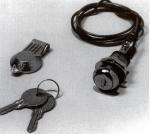
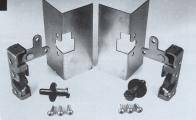 Latches… The Last Thing Comes First
Latches… The Last Thing Comes First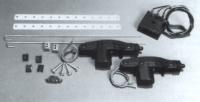

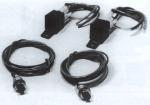


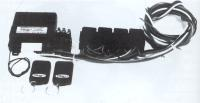
WHEN I LIVED IN CALIFORNIA I GOT A RED PUSHBUTTON START WITCH AN A BUNCH OTHER PARTS BUT I LOST THE INFO FOR THE START BUTTON WHEN I MOVED Tenn. how can I get info on wiring the start witch ?